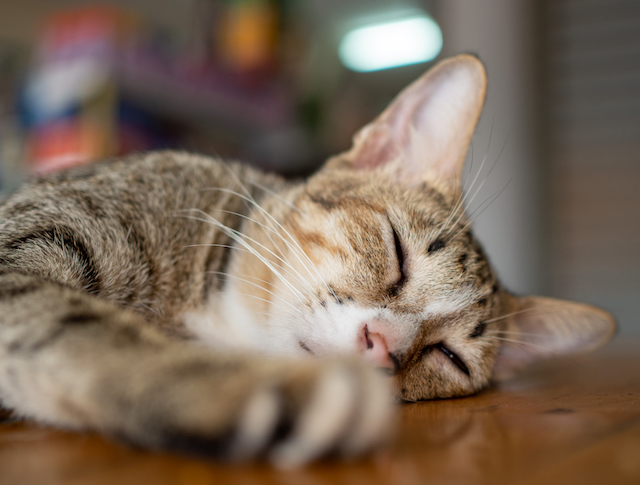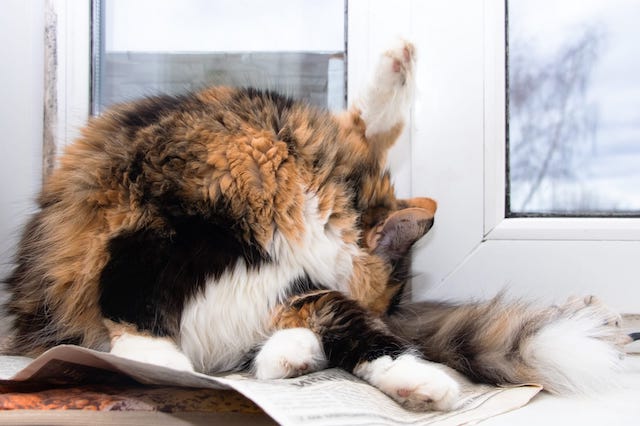If you have an indoor cat, you may have assumed that fleas aren’t something you’ll ever have to worry about. Unfortunately, though, that isn’t the case.
While fleas are a bit less common in indoor cats, they are still a very real possibility, and they could become a major issue for you and your fur baby. Don’t worry, though. You’re about to learn how to tell if your indoor cat has fleas.
Let’s get started!
Why Fleas are a Problem for Cats
Fleas are a common problem for cats, and they can cause a range of issues for our feline friends.
Fleas are small, blood-sucking insects that can cause discomfort, irritation, and even transmit diseases.
Below are some of the reasons flea infestations are harmful to cats.
Flea Bites
The most obvious problem that fleas cause for cats is flea bites. Fleas feed on the blood of their host, and when they bite a cat, it can cause itching, scratching, and discomfort.
Some cats may be allergic to flea saliva, which can cause an even more severe reaction. Flea bites can also lead to skin infections if a cat scratches too much and breaks the skin.
Anemia
Fleas can also cause anemia in cats. Anemia occurs when there are not enough red blood cells in the body, leading to weakness, lethargy, and even death in severe cases.
Fleas feed on blood, and if a cat has a large number of fleas, they can lose a significant amount of blood over time.
Tapeworms
Fleas can transmit tapeworms to cats. Tapeworms are a type of intestinal parasite that can cause weight loss, vomiting, and diarrhea in cats.
When a cat ingests a flea that is infected with tapeworms, the tapeworm larvae can hatch in the cat’s intestine and grow into adult tapeworms.
Disease Transmission
Fleas can also transmit diseases to cats. The most common disease that fleas transmit is cat scratch fever, caused by Bartonella henselae.
Cat scratch fever can cause fever, swollen lymph nodes, and in rare cases, more severe symptoms.
Fleas can also transmit other diseases, such as typhus and plague, although these are rare in cats.
Stress
Finally, fleas can cause stress for cats. Fleas can be incredibly irritating and uncomfortable for cats, which can lead to stress and anxiety.
Cats may scratch and groom excessively to try to get rid of the fleas, which can lead to skin irritation and infections.
Additionally, cats may avoid certain areas of their home or become less active if they are uncomfortable due to fleas.
Signs and Symptoms of Fleas on Cats

Knowing the signs and symptoms of fleas on cats can help you prevent and treat an infestation.
Here are the signs to look out for:
- Scratching and biting: Cats with fleas will scratch and bite themselves excessively, particularly in the head, neck, and tail regions.
- Flea dirt: This is the flea feces that looks like black specks on your cat’s fur. To test for flea dirt, place a damp paper towel under your cat’s fur and brush it. If the paper towel turns red, it’s flea dirt.
- Hair loss: Cats with fleas may experience hair loss due to constant scratching and biting.
- Skin irritation: Fleas can cause redness, inflammation, and small scabs on your cat’s skin.
- Lethargy: Cats with severe flea infestations may become lethargic and lose their appetite.
Here’s How to Inspect Your Cat for Fleas

Part of knowing how to tell if your indoor cat has fleas is knowing how to check for them. Below, we’ll explain exactly what you’ll need to do to see if your cat has fleas.
What You’ll Need
Before you start inspecting your cat for fleas, there are a few items you’ll need:
- A fine-toothed flea comb
- A white towel or paper towel
- A bright light source
Step-by-Step Guide to Inspect Your Cat for Fleas
- Get your cat comfortable: Before you start inspecting your cat for fleas, make sure they are comfortable. Find a quiet and comfortable spot where you can inspect them, and make sure they are relaxed.
- Use a flea comb: Use a fine-toothed flea comb to comb through your cat’s fur. Start at the head and work your way down the body. Pay special attention to the neck, back, and tail, as these are the areas where fleas are most commonly found.
- Check the comb: After combing through your cat’s fur, check the comb for fleas. If you find any fleas, use a white towel or paper towel to wipe them off the comb. The white towel or paper towel will make it easier to see the fleas.
- Look for flea dirt: Flea dirt is the feces of fleas, and it looks like tiny black specks. Check your cat’s fur for flea dirt, especially around the neck, back, and tail. You can use a bright light source to help you see the flea dirt better.
- Check for signs of skin irritation: Flea bites can cause skin irritation and redness. Check your cat’s skin for any signs of irritation or redness, especially around the neck, back, and tail.
- Repeat regularly: Inspect your cat for fleas regularly, especially during flea season (usually in the summer months). This will help you catch fleas early and prevent an infestation.
Treatment and Prevention of Indoor Cat Fleas

Fleas are a common problem for cats, and they can cause discomfort, irritation, and even transmit diseases. If you have an indoor cat, you may think that they are safe from fleas, but unfortunately, fleas can still find their way into your home. In this post, we’ll discuss the treatment and prevention of indoor cat fleas.
Treatment of Indoor Cat Fleas
If you suspect that your indoor cat has fleas, there are a few steps you can take to treat the problem:
- Consult with your veterinarian: Before starting any treatment, it’s important to consult with your veterinarian. They can recommend the best treatment for your cat based on their age, weight, and overall health.
- Use flea medication: Your veterinarian may recommend flea medication for your cat. There are several types of flea medication available, including topical treatments, oral medications, and flea collars. Follow your veterinarian’s instructions carefully when administering the medication.
- Clean your home: Fleas can lay eggs in your carpets, furniture, and bedding, so it’s important to clean your home thoroughly. Vacuum your carpets and furniture, wash your bedding in hot water, and use a flea spray or powder to treat your home.
- Repeat treatment: Fleas can be difficult to get rid of, so it’s important to repeat treatment as necessary. Your veterinarian may recommend a follow-up appointment to ensure that the fleas are gone.
Prevention of Indoor Cat Fleas
Preventing fleas from entering your home in the first place is the best way to keep your indoor cat flea-free. Here are a few steps you can take to prevent indoor cat fleas:
- Keep your home clean: Regularly cleaning your home can help prevent fleas from entering. Vacuum your carpets and furniture, wash your bedding in hot water, and keep your home clutter-free.
- Use flea preventative medication: Flea preventative medication can help keep fleas away from your cat. Your veterinarian can recommend the best flea preventative for your cat.
- Check for fleas regularly: Even if your cat is indoor-only, it’s still a good idea to check them for fleas regularly. Use a fine-toothed flea comb to comb through your cat’s fur and check for flea dirt.
- Treat other pets: If you have other pets in your home, it’s important to treat them for fleas as well. Fleas can easily jump from one pet to another, so treating all pets in your home is necessary.
Now You Know How to Tell if Your Indoor Cat Has Fleas!
By following the tips and advice in this post, you can help keep your indoor cat flea-free and ensure that they stay healthy and happy.
Remember, prevention is the best medicine when it comes to flea infestations, so make sure to use preventative measures to avoid the hassle and discomfort of a flea problem.

